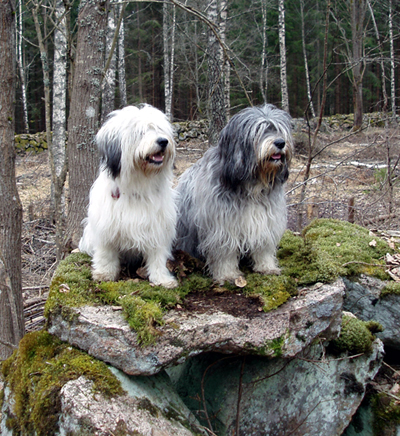The food companies have been paying attention. Hillís prescription
diet b/d canine provides high levels of vitamins C and E as well as L-carnitine,
an amino acid found in muscle meat, to reduce oxidative stress,
increase energy availability to the brain, and improve nerve signal
transmission. The best results were seen if the dogsí environment
was stimulating and rich during laboratory testing.
Brain levels of BDNF in older dogs were close to those found in young
ones. Purinaís EN Canine diet uses MCTs and omega-3 and omega-6
fatty acids also hoping to reduce oxidative stress. I do worry about
deterioration of EFAs in processed foods though, so I
advise supplementing the diet with them. Coconut oil is a great source
of MCTs, and my dogs get both that and fish oil.SAM-e, s-adenosylmethionine,
influences nerve-cell communication by increasing the activity of
dopamine and serotonin; it also helps to maintain the structure and
fluidity of nerve cell membranes potentially enhancing electrical
activity from cell to cell. SAMe
reduces inflammation in joints and protects liver and kidney function,
all of which make it a good choice for older dogs.Another supplement
that may help is Senilife (Ceva Sante Animale) which uses an
antioxidant resveratrol, structural enhancers of nerve membranes and a
coenzyme needed for neurotransmitter function. You will likely hear of
others, but Iíve no experience with them.
For many vets the first line of attack on CD is selegiline (Anipryl).
It inhibits the breakdown of the neurotransmitters -
serotonin,norepineprhine and dopamine, with the greatest effect being
on dopamine. As a result, thereís more neurotransmitter stimulation
of
neurons, their communication (synapses) are maintained, and BDNF can
do its thing. Selegiline works best as a preventative or if it is
given at the first signs of CD. If the dog exhibits non specific signs
of increased anxiety, tricyclic antidepressants (amitriptyline) or
selective serotonin uptake inhibitors (Prozac) may help. They increase
neuronal communication and keep nerve cells plump and active. If sleep
cycle disruption is the only sign, melatonin at bedtime may rectify
the situation.
Maintaining or increasing cognitive and physical stimulation is of
utmost importance as dogs (and humans) age in order to maintain
healthy brain function. Exercise should be matched to the dogís
breed, behavior and health, but even arthritic dogs benefit from a
walk and massage. Swimming and underwater treadmills provide great
exercise with less strain on sore joints. If your old dog can no
longer jump for a ball or Frisbee, he can still chase a rolled ball.
Rolling food toys or ones that make a noise maintains eye paw
coordination, puzzle toys are great for encouraging thinking, and
noisy toys may help dogs with reduced vision, while using odors
can benefit those losing their hearing or sight. Amyloid deposits are
found in the olfactory neurons as well as other parts of the brain, so
encouraging your old Beardie to follow scent paths or a nice meaty
bone dragged through the grass is a therapy heíll love.
Warming food or adding a warm broth (or green tripe) will help
stimulate less active olfactory cells and encourage appetite if it is
failing. Teach him new tricks, introduce the clicker if you havenít
already, and work on the old behaviors he knows too. Five minutes
three or four times a day can provide a huge improvement. If you get
up, encourage your dog to come with you.
Contrary to popular belief, adding a new puppy or older dog to the
household can also provide helpful mental and physical
stimulation.Just be sure the old dog can get away if the puppy is
being a pest; they both need their down time and naps. Donít leave
the older Beardie home just because heís old and slow; do what it
takes to keep him involved and get him out there.
Further updates on BCCA supported research with AKC-CHF Those of you
who attended the 2009 national specialty and attended the seminar
given by Jaime Modiano are aware of the work
done by his group. His study, Genetic Background and the Angiogenic
Phenotype in Cancer, attempted to unravel the genetics behind the
observation that certain dog breeds are more prone to specific types
of cancer. He has demonstrated that the dogís genes not
only determine what type of tumor cells appear but also their
subsequent behavior. His study has involved hemangiosarcoma in
GermanShepherds, Golden Retrievers and Portuguese Water Dogs. The
groupís work has shown that the tumors differ at the submicroscopic
level by breed, and early research suggests that how the tumors
develop and their response to treatment may also be breed dependent.
One size does not fit all. Dr. Susan Volkís group looked at tissue
regeneration using canine mesenchymal stem cells (MSCs): effects of
donor characteristics
and ex vivo expansion on cell pluripotency. Mesenchymal stem cells are
derived from bone marrow and can be used to produce different types of
cells that form bone, muscle, cartilage or nervous tissue. They can
then be returned to the body to replace tissue damaged by trauma,
infection, inherited or age associated conditions and restore function
to a wide variety of organs and tissues. While
MSCs are being used clinically in dogs, humans and horses, we are
still somewhat in the dark as to many of their basic properties.
The study has shown that the age of the dog the cells were harvested
from as well as the site from which they were taken both influence the
ability to grow bone cells from MSCs. Expansion - making more cells
from the MSCs - is also important for them to be clinically effective.
The study showed that expansion affects the cells, and needs to be
better understood so that the use of MSCs is
both safe and most effective. The study has shown that the behavior of
canine MSCs is not identical to that of other species, and needs
further examination.
Written by Linda Aronson, DVM
A grateful thank you for the use of this article.

